รูปแบบความเป็นองค์กรนวัตกรรมเพื่อการพัฒนาทรัพยากรมนุษย์ของธนาคารพาณิชย์ไทย
Keywords:
The Innovative Organization of model, Thai Commercial BanksAbstract
The purposes of this research were to 1) study the condition of the innovative organization for human resource development of Thai commercial banks, and 2) develop and examine the consistency of confirmatory factor analysis model of casual factors influencing the innovative organization for human resource development of Thai commercial banks. The quantitative and qualitative research methodology.
The results of this research revealed that 1) the condition of the innovative organization for human resource development of Thai commercial banks emphasizes on the human resource development as the important human capital of the organization. Thai commercial banks consequently contain the human resource development plan in the vision of organization. Thai commercial banks have the basic beliefs that the capability of the efficient human resource management can be developed by the process of proficiency development. 2) The model of the innovative organization for human resource development of Thai commercial banks, called “KOCI Model”, consists of vision, mission, and goal. The elements of the innovative organization consist of 1) K = Knowledge Management, 2) O = Organizational Learning, 3) C = Cultural Learning, and 4) I = Innovative Organization. All elements are statistically significant at the .05 level and have the measure reliability in high level. The result of the model consistency examination revealed that model suits to the empirical data. (c2= 121.79, p = 0.06844, GFI= 0.96, AGFI = 0.95, RMSEA = 0.02, CN = 437.38)
References
กีรติ ยศยิ่งยง. (2552). องค์กรแห่งนวัตกรรม: แนวคิดและกระบวนการ. กรุงเทพฯ: จุฬาลงกรณ์มหาวิทยาลัย.
ธิดา จุลินทร. (2549). กระบวนการและปัจจัยความสำเร็จของการจัดการความรู้ในองค์กร: กรณีศึกษา ศูนย์สุขภาพจิตเขต กรมสุขภาพจิต. ภาคนิพนธ์ศิลปศาสตรมหาบัณฑิตสาขาวิชาพัฒนาสังคม คณะพัฒนาสังคม สถาบันบัณฑิตพัฒนบริหารศาสตร์
วันทนีย์ ซื่อสัตย์. (2549). แนวทางการพัฒนานวัตกรรมในองค์การ กรณีศึกษา บริษัทแอดวานซ์อินโฟร์เซอร์วิส จำกัด (มหาชน) และบริษัท ปตท. จำกัด (มหาชน). ภาคนิพนธ์โครงการ
บัณฑิตศึกษาการพัฒนาทรัพยากรมนุษย์ สถาบันบัณฑิตพัฒนบริหารศาสตร์.
ศัชชญาส์ ดวงจันทร์. (2551). รูปแบบการจัดการความรู้เพื่อเพิ่มประสิทธิผลการทำงานในองค์กร. กรุงเทพฯ: หาวิทยาลัยเกษตรศาสตร์.
Amabile, T. M. (2008). “Studying creativity, its processes, and itsantecedents: An exploration of the componential theory of creativity”. In Handbook of Organizational Creativity, 33-64.
Delahaye, B.L. (2005). Human Resource Development: Adult Learning and Knowledge Management. 2 nd ed. Milton, Qld: John Wiley Press.
Panayides, P. (2006). “Enhancing Innovation Capability through Relationship Management and Implications for Performance.” European Journal of Innovation Management, 9(48), 489- 518.
Prahalad, C. K., and G. Hamel. (1999). “Competing in the New Economy: Managing out of Bounds”. Strategic Management Journal 68, 237-344.
Senge, P.M. (1990). The Fifth Discipline: The Art and Practice of the LearningOrganization. New York: Doubleday.
Swanson, R.A. & E. F. Holton. (2001). Foundations of Human Resource Development. SanFrancisco: Berrett-Koehler.
Downloads
Published
How to Cite
Issue
Section
License
"บทความวิชาการในวารสารฉบับนี้ ถือเป็นความรับผิดชอบของผู้เขียนเท่านั้น"
สงวนลิขสิทธิ์ตามพระราชบัญญัติลิขสิทธิ์




